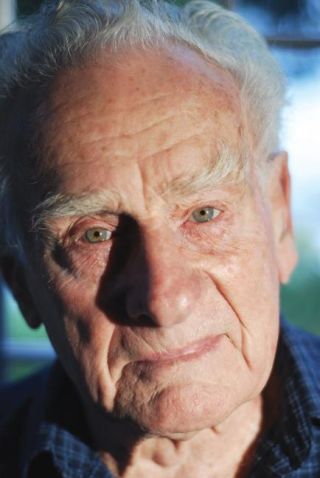Islander is infantryman in famous D-Day photo
By Rebecca Mar
Mercer Island Reporter
Huston Riley is a D-Day hero. More than 60 years ago, this quiet, unassuming grandfather risked his life with thousands of others on Normandy’s shores in France during the largest amphibious assault of World War II.
The victorious invasion was captured forever by photojournalist Robert Capa in the photo entitled “American soldier landing on Omaha Beach, D-Day, June 1944.” The photo, featuring a single soldier struggling through the surf and enemy fire to reach the shore, is said by some to have been the inspiration for the intense opening sequence of the film, “Saving Private Ryan,” starring actor Tom Hanks.
Riley, a lifelong resident of Mercer Island, is the soldier in that famous photograph.
A 30-by-30-foot reproduction of the photograph is currently on display at the International Center of Photography’s museum exhibition, “This is War! Robert Capa at Work,” in New York, N.Y. Riley and his wife, Charlotte, recently visited the exhibit, where he was acknowledged as the soldier in the photo.
Riley, now 86, and his wife live on North Mercer waterfront in the house built by his father, Howard, in 1905 — the house where Riley was born. His parents, Howard and Veta Riley, are considered Island pioneers and lived on the Island until the mid-1940s.
Private First Class Huston Riley, 16th Regiment, 2nd Battalion, Company F, landed on Omaha Beach with the Allied forces’ first wave of the D-Day invasion, Operation Overlord, June 6, 1944. His landing craft came to rest on a sandbar dozens of yards from the shore.
“We all jumped out,” he said. “I went into [the water and sank] 14 feet, clear to the bottom.” Only nine men got out, he added, because the landing craft rolled over onto its side.
Riley struggled toward land with a heavy load on his back as German bullets rained down on the beachhead and strafed the water. He was hit several times but was not seriously injured until he reached the shore, where machine gun fire hit his shoulder.
Riley remembers that a photographer and another man, a sergeant, pulled him out of the water to safety. The photographer was Robert Capa, Riley later realized.
“He took his chances — he was a wild one,” Riley said, describing Capa.
Just one-quarter of the soldiers in Riley’s company survived the invasion.
“It was a miserable day. It was tough to see [soldiers] strewn around, not living. That was a…bloody mess,” said Riley.
When Capa’s photograph of the unidentified American soldier appeared in “LIFE” magazine, Veta Riley recognized him as her son, Huston. The soldier’s identity, however, was debated for years. Edward Regan of Atlanta, Ga., was the other possible candidate, but he landed on Utah Beach instead of Omaha, according to research by Lowell Getz, military historian and former University of Illinois professor.
“Given Hu Riley’s resemblance to the GI in the surf, his location and movements during the time that Robert Capa would have been snapping his legendary photograph, Riley is most likely the best candidate we will ever have,” Getz wrote in “WWII: Who is the Face in the Surf in Robert Capa’s Photo from ‘Bloody Omaha,’” an article published in the “World War II” magazine.
And in the book “This is War! Robert Capa at Work,” Richard Whelan wrote: “Since 1985…military historians, including Lowell Getz, have determined that Regan was certainly not the man whom Capa photographed.” Whelan is the exhibition curator at the International Center of Photography, which affirms that Riley was the man in Capa’s photo.
“It was me,” said Riley, matter-of-factly. “I remember swimming in and pushing my lifebelt in front of me.”
Riley served in the U.S. Army from January 1942 to September 1945. Initially, he joined the paratroopers before transferring to an infantry division. After participating in the North Africa campaign and the invasion of Sicily, Italy, Riley was wounded at Omaha and went to a hospital in England. He then fought in the Battle of the Bulge and was wounded again.
After World War II, Riley raised a son and daughter and started his own business, H&R Sales. He traveled on business and sold sporting goods for 35 years. He has been active with Mercer Island’s Veterans of Foreign Wars (VFW) Post for decades, selling poppies and playing games and cards with hospital patients.
Since D-Day, Riley has returned only once to the shores of Normandy.
“I walked down to the same place I came in on,” he said. Back then, he had been under fire; 50 years later, all was at peace. “It was kinda nice. It brought back memories.”
For more information about the “This is War! Robert Capa at Work” exhibit, visit www.icp.org.


